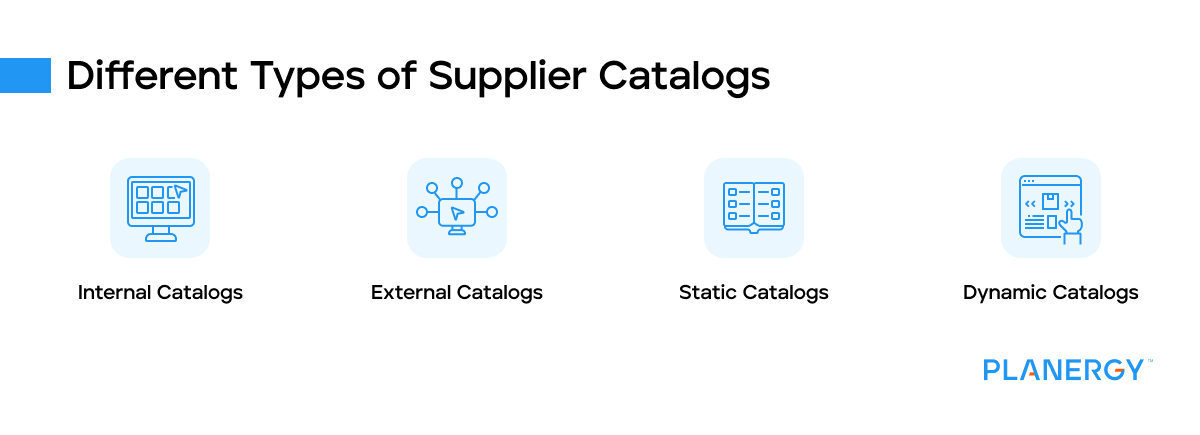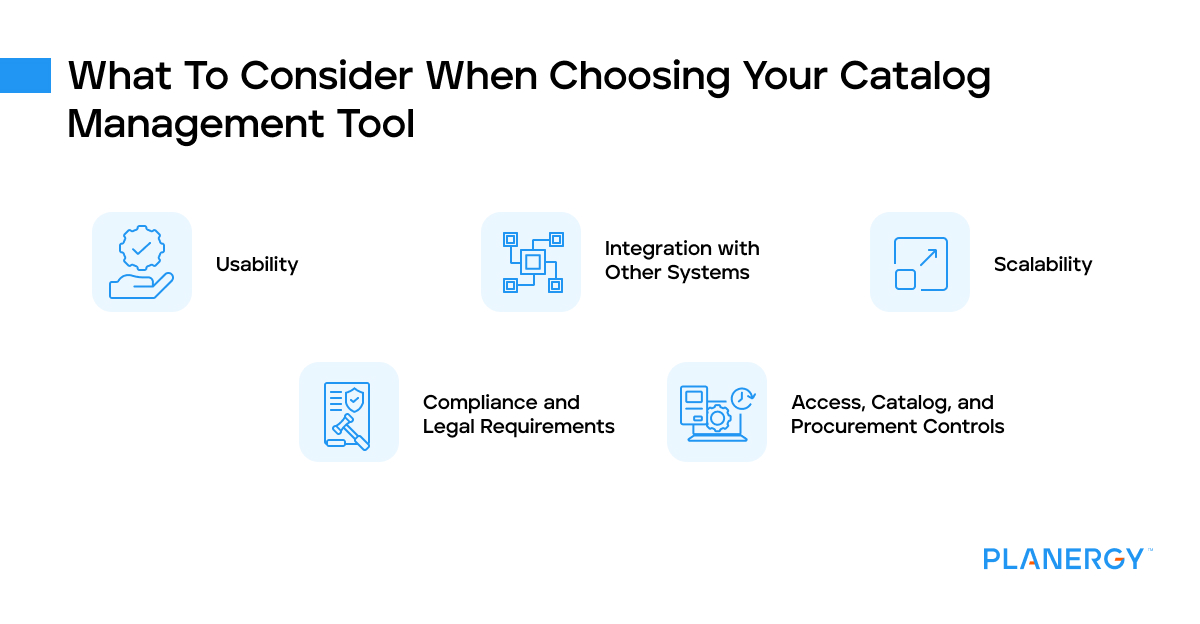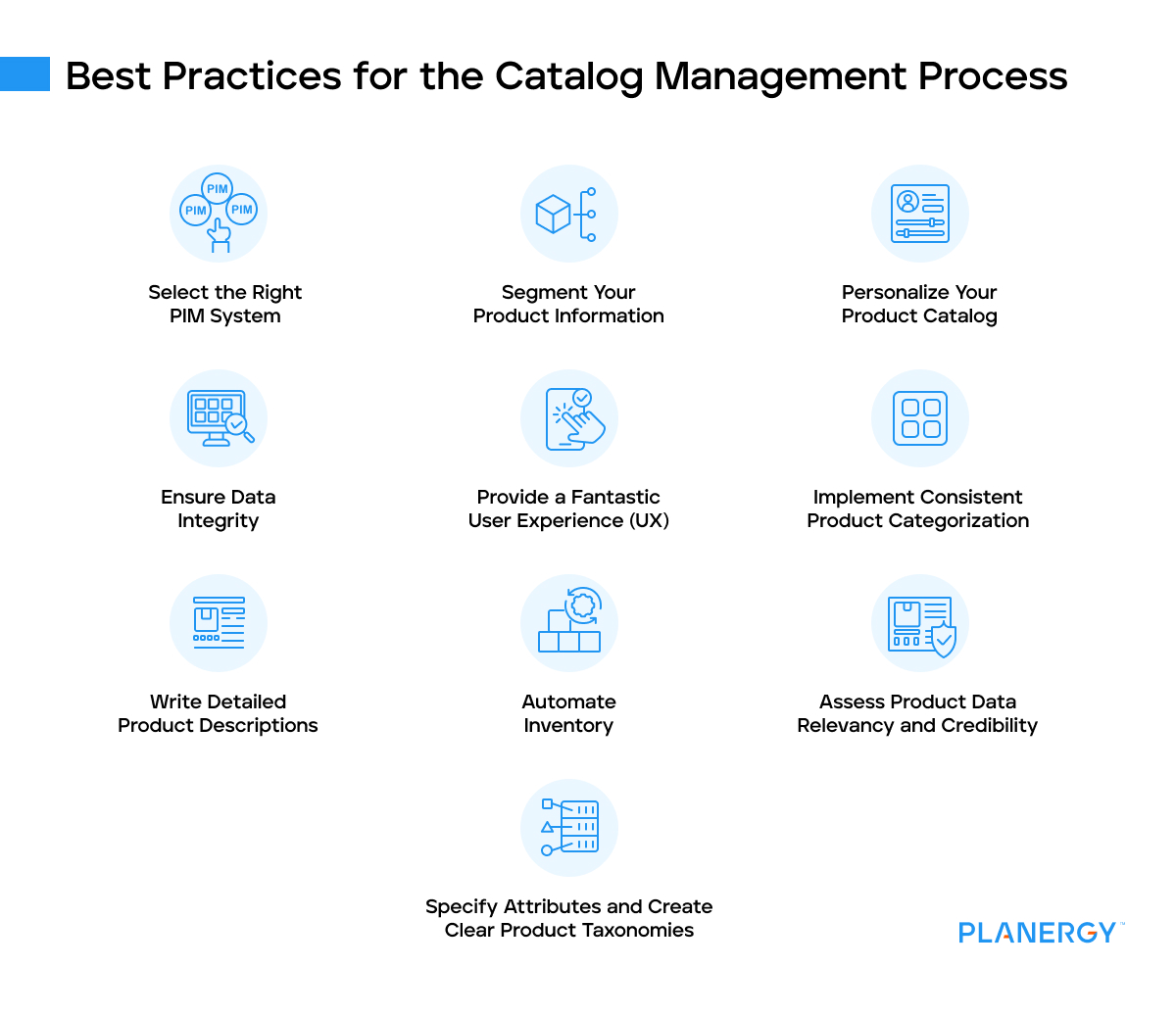Catalog management in procurement is the strategic process of managing and maintaining a product catalog within an organization.
It ensures that suppliers’ products, services, and pricing are consistent, accurate, and up-to-date. This vital process streamlines purchasing, enhances spend visibility, and improves supplier relationship management.
Different Types of Supplier Catalogs
Understanding the different types of supplier catalogs providers use can help streamline your procurement process. Here are the four main types of digital catalogs.
Internal Catalogs
These are created and maintained within the organization. They include products or services sourced from multiple suppliers or distributors and are standardized according to the company’s requirements.
External Catalogs
Suppliers provide these catalogs. They contain detailed information about the products or services they offer. There are two types of external catalogs – vendor self-managed and punch-out catalogs.
Supplier-managed catalogs live within the buyer’s purchasing system, but the supplier has access to the catalog so they can maintain it.
On the other hand, a punch-out catalog gives buyers access to the vendor’s website through the buyer’s procurement software.
Static Catalogs
Static catalogs are non-interactive, meaning product details remain constant until someone manually updates them. This is the most time-consuming type of catalog since it can quickly go out of date and requires frequent updates.
Dynamic Catalogs
In contrast, dynamic catalogs are interactive, allowing real-time price updates, availability, and other product details based on external factors.
These are usually handled with a catalog management solution connected to your system via API – allowing you to make edits in one place and push the updates live to all the places where your catalog is used.
However, the frequency that dynamic catalogs are updated can vary greatly. So there can still be a risk of out of date data.

Tools for Catalog Management
Suppliers use various tools for catalog management.
These range from basic Excel spreadsheets for small-scale catalog management to more advanced systems like Product Information Management (PIM) systems, which allow suppliers to manage complex product information across multiple channels.
Procurement software offers robust features for catalog management, including integration with eCatalogs and PunchOut catalogs.
Modern suppliers like Amazon Business use the PunchOut catalog format. But, you will likely have a mix of suppliers that offer varying options for catalog integration.
Planergy is an Amazon Business partner with an approved integration with PunchOut and Amazon Business’ own Punch-in format. We also support integration with other PunchOut catalogs and other options for integration and ordering online.
The catalog management tool you choose needs to be based on several factors, including:
Usability
Is it easy for your team to understand and use? If you already have a catalog, can you import it and update it accordingly?
If you’re starting the catalog creation process from scratch, does it have the configurable options you need to make maintaining high-quality data and procurement analysis possible?
Integration with Other Systems
Does the procurement system integrate with the other tools you use across your supply chain?
For example, does it connect to your ERP, e-commerce platform, and inventory management system? Does it integrate with relevant marketplaces and other channels you use?
Scalability
As your product catalog management system grows, you may run into performance issues like poor data loading time or even complete system failure.
As the volume of information increases, you need more data management resources.
Whether that’s hardware to support the system, software to manage the data, or staff to update product information, you need something that can quickly adapt as you grow.
Compliance and Legal Requirements
All businesses must provide prospective buyers with compliant information applicable to industry regulations and laws. It can be quite a burden, as many regulations exist, from product safety to labeling and privacy legislation.
If you purchase globally, ensuring compliance with multiple international data regulations is crucial.
Access, Catalog, and Procurement Controls
Having an up to date and accurate catalog for all your preferred vendors and approved vendor list is a good starting point. But should everyone be able to order anything from any supplier?
Controlling what each individual can order, who should approve different types or values of purchases, budget management, and much more will be covered by a procure-to-pay software, like Planergy.

No matter how many products you have, or what your ideal customer looks like, effective product catalog management can improve your bottom line.
Catalog Management Challenges
Catalog management is a critical function in procurement, but it comes with its unique set of challenges.
The process involves organizing and maintaining a product or services catalog to streamline procurement operations.
However, the task becomes complicated due to factors such as maintaining data accuracy, ensuring catalog compliance, and ineffective catalog maintenance.
Maintaining Catalog Compliance
This involves aligning the catalog with the company’s procurement policies and regulations, which can be daunting.
Non-compliance can lead to legal issues, reputational damage, and financial loss.
The challenge arises when suppliers update their products or services, change their pricing, or when companies revise their procurement policies, making it challenging to maintain constant compliance.
Regular audits can help identify any discrepancies early and allow for corrective measures.
Establish clear communication channels with suppliers to facilitate prompt updates about product, service, or pricing changes.
Train the procurement team on the importance of catalog compliance and how to ensure it can also be beneficial.
Keeping Catalog Data Accurate
Data accuracy is the backbone of effective catalog management. Inaccurate data can lead to wrong decisions, over or under-stocking, and financial loss.
Incorrect data makes it impossible to turn your big data into actionable insights.
The challenge lies in the fact that catalogs are often handled by multiple individuals across different departments, increasing the chances of human error. Suppliers might provide incorrect information, or items may be duplicated.
Centralizing everything with catalog management software is the best option to keep the data current and accurate. This makes identifying and correcting errors, removing duplicates, and updating outdated information easier.
With an adequate PIM, you can automate the process. But, it’s crucial to have strict data entry protocols and train staff on using them appropriately so that information is consistent across the board.
Consider using templates with all the necessary information, such as SKU, product description, category, etc.
Maintaining Effective Catalog Management and Maintenance
Ineffective catalog maintenance and management can disrupt procurement, causing delays, increased costs, and operational inefficiency.
The challenge here is keeping up with the constant updates from suppliers, technological advancements, and changes in organizational needs.
To address this, use a comprehensive and flexible procurement software tool like Planergy to help with catalog maintenance.
It allows for easy integration with eCatalogs and Punchout catalogs, provides real-time updates, and facilitates internal catalog management.

Best Practices for the Catalog Management Process
Catalog management is crucial to procurement, and implementing best practices can significantly enhance its effectiveness.
Select the Right PIM System
A PIM centralizes your product information to keep it consistent and accurate across multiple platforms.
Not all systems are created equally, so choosing the right one for your business is essential. Demo multiple platforms before adding all your product content.
For instance, some PIM systems also include digital asset management (DAM) tools. DAM systems manage your creative assets, including product images, marketing creatives, and more. Linking to the two can make content enrichment easier.
This provides everyone with a single source of truth for data – making it easier to keep it consistent and accurate across the board.
This ensures a positive customer experience, because no matter where they find your product information, it is the same – eliminating potential confusion and making the purchase decision easier.
Segment Your Product Information
Break down your product information into different categories or segments to make managing and locating specific items easier.
The category management process can be very beneficial in procurement.
How you choose to segment the data is entirely up to you but consider how you might want to restrict ordering of categories of items as well as how you would like to analyze spend.
Good categorization and good control of the data can help automate spend analysis.
Personalize Your Product Catalog
Personalizing your product catalog to align with your business needs can significantly improve efficiency and user experience.
You can adjust the layout, design, navigation, and tailor custom fields to meet the specific needs of your customers or employees.
Ensure Data Integrity
Ensure your catalog’s data is accurate, consistent, and up-to-date.
Include regular audits in your workflow to review your catalog data for errors, outdated information, and duplicate products. You want to ensure the information is the same across all touchpoints.
Factor in catalog management to your supplier onboarding process to ensure new suppliers are accounted for as you start to purchase from them.
Provide a Fantastic User Experience (UX)
A well-organized, easy-to-navigate catalog can enhance user satisfaction and increase the likelihood of repeat purchases from the perspective of the supplier.
Suppliers should review and update often to ensure it remains user-friendly to ensure customer experience management.
The same applies when managing catalogs for procurement. The easier it is to use the better internal procurement compliance will be and the easier it will be to onboard new employees.
Implement Consistent Product Categorization
This is crucial for easy navigation. Create and use a consistent set of categories and subcategories across your catalog so it’s easy for people to find what they’re looking for.
Write Detailed Product Descriptions
The more information you can include in your product descriptions, the better. Include all relevant details, including features, benefits, and specifications.
This will reduce the risk of errors and discrepancies and reduce your return rate.
Automate Inventory
Automating your inventory management can maintain real-time updates of inventory levels, preventing you from ordering too much stock or having too little on hand.
Connecting your inventory management system allows it to update quantity information based on sales.
Assess Product Data Relevancy and Credibility
To keep your online catalogs relevant to your audience, regularly review the product data to ensure it meets current market trends and customer expectations. Remove or update any outdated or irrelevant information.
Specify Attributes and Create Clear Product Taxonomies
Clearly define product attributes and organize them into clear, logical categories. Training your team on these features and how you want them used is important when adding new products or updating existing product listings to ensure consistency.

Common Questions About Catalog Management in Procurement
What Is the Role of Catalog Management in Procurement?
Catalog management is crucial in procurement as it ensures that all product or service information is accurate, up-to-date, and consistent, streamlining the purchasing process.
What Are the Challenges of Managing Supplier Catalogs?
Challenges include keeping the catalogs up-to-date, dealing with multiple types of catalogs, and ensuring consistency across all platforms.
What Are the Components of Procurement Catalogs?
There are several components: catalog content, processes, buyer/seller relationships, establishment of pricing, billing management, data storage and transmission, system maintenance, and user maintenance.
Catalog management is a multi-faceted process that requires careful planning and execution.
By adhering to these best practices, businesses can optimize their strategy, leading to streamlined operations, improved customer satisfaction, and increased profitability.





